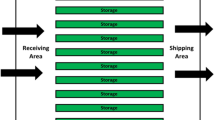Abstract
This paper develops a framework for examining the effect of demand uncertainty and forecast error on unit costs and customer service levels in the supply chain, including Material Requirements Planning (MRP) type manufacturing systems. The aim is to overcome the methodological limitations and confusion that has arisen in much earlier research. To illustrate the issues, the problem of estimating the value of improving forecasting accuracy for a manufacturer was simulated. The topic is of practical importance because manufacturers spend large sums of money in purchasing and staffing forecasting support systems to achieve more accurate forecasts. In order to estimate the value a two-level MRP system with lot sizing where the product is manufactured for stock was simulated. Final product demand was generated by two commonly occurring stochastic processes and with different variances. Different levels of forecasting error were then introduced to arrive at corresponding values for improving forecasting accuracy. The quantitative estimates of improved accuracy were found to depend on both the demand generating process and the forecasting method. Within this more complete framework, the substantive results confirm earlier research that the best lot sizing rules for the deterministic situation are the worst whenever there is uncertainty in demand. However, size matters, both in the demand uncertainty and forecasting errors. The quantitative differences depend on service level and also the form of demand uncertainty. Unit costs for a given service level increase exponentially as the uncertainty in the demand data increases. The paper also estimates the effects of mis-specification of different sizes of forecast error in addition to demand uncertainty. In those manufacturing problems with high demand uncertainty and high forecast error, improved forecast accuracy should lead to substantial percentage improvements in unit costs. Methodologically, the results demonstrate the need to simulate demand uncertainty and the forecasting process separately.


Similar content being viewed by others
References
Aviv Y (2001). The effect of collaborative forecasting on supply chain performance . Mngt Sci 47: 1326–1343.
Aviv Y (2002). Gaining benefits from joint forecasting and replenishment processes: the case of autocorrelated demand . Manuf Serv Ops Mngt 4: 55–74.
Babai MZ and Dallery Y (2009). Dynamic versus static control policies in single stage production-inventory systems . Int J Prod Res 47: 415–434.
Box GEP and Müller ME (1958). A note on the generation of random normal deviates . Ann Math Stat 28: 610–611.
Chen F, Drezner Z, Ryan J and Simchi-Levi D (2000a). Quantifying the bullwhip effect in a simple supply chain: The impact of forecasting, lead times, and information . Mngt Sci 46: 436–443.
Chen F, Ryan J and Simchi-Levi D (2000b). The impact of exponential smoothing forecasts on the bullwhip effect . Nav Res Log 47: 271–286.
De Bodt MA and Van Wassenhove L (1983a). Cost increases due to demand uncertainty in MRP lot sizing . Decis Sci 14: 345–361.
De Bodt MA and Van Wassenhove L (1983b). Lot sizing and safety stocks in MRP: A case study . Production and Inventory Mngt 24(1): 1–16.
Dolgui A and Prodhon C (2007). Supply planning under uncertainties in MRP environments: A state of the art . Annu Rev Control 31: 269–279.
Enns ST (2002). MRP performance effects due to forecast bias and demand uncertainty . Eur J Opl Res 138: 87–102.
Fildes R and Beard C (1992). Forecasting systems for production and inventory control . Int J Ops Prod Mngt 12(5): 4–27.
Fildes R and Goodwin P (2007). Against your better judgment: Do organizations follow best practice when applying management judgement to forecasting? Interfaces 37: 570–576.
Fildes R and Kingsman B (1997). Demand uncertainty in MRP systems: The value of forecasting. Department of Management Science Working Paper 01/97, Lancaster University.
Fildes R, Hibon M, Makridakis S and Meade N (1998). Generalising about univariate forecasting methods: Further empirical evidence . Int J Forecasting 14: 339–358.
Fildes R, Goodwin P, Lawrence M and Nikolopoulos K (2009). Effective forecasting and judgmental adjustments: An empirical evaluation and strategies for improvement in supply-chain planning . Int J Forecasting 25: 3–23.
Forrester JW (1961). Industrial Dynamics . MIT Press: Cambridge, Mass.
Gardner ES Jr, (1990). Evaluating forecast performance in an inventory control system . Mngt Sci 36: 490–499.
Jeunet J (2006). Demand forecast accuracy and performance of inventory policies under multi-level rolling schedule environments . Int J Prod Econ 103: 401–419.
Johnston FR, Taylor SJ and Oliveria RMMC (1988). Setting company stock levels . J Opl Res Soc 39: 15–21.
Law AM and Kelton WD (2000). Simulation Modelling and Analysis . McGraw Hill: New York.
Lee HL, Padmanabhan V and Whang S (1997). The bullwhip effect in supply chains . Sloan Mngt Review 38(3): 93–102.
Lee H, So KC and Tang CS (2000). The value of information sharing in a two-level supply chain . Mgmt Sci 46: 626–643.
Lee TS and Adam EE Jr, (1986). Forecasting error evaluation in material requirements planning (MRP) production-inventory systems . Mngt Sci 32: 1186–1205.
Lee TS, Adam EE and Ebert RJ (1987). An evaluation of forecast error in master production scheduling for material requirements planning systems . Decis Scis 18: 292–307.
Lee TS, Cooper FW and Adam EE Jr, (1993). The effects of forecasting errors on the total cost of operations . Omega 21: 541–550.
Makridakis S and Hibon M (2000). The M-3 competition: results, conclusions and implications . Int J Forecasting 16: 451–476.
Newbold P and Bos T (1989). On exponential smoothing and the assumption of deterministic trend plus white noise data-generating models . Int J Forecasting 5: 523–527.
Orlicky J (1975). Material Requirements Planning . McGraw-Hill: New York.
Ritzman LP and King BE (1993). The relative significance of forecast errors in multistage manufacturing . J Ops Mngt 11: 51–65.
Silver EA, Pyke DF and Peterson R (1998). Inventory Management and Production Planning and Scheduling, 3rd edn. Wiley: New York.
Vargas GA and Dear RG (1991). Managing uncertainty in multilevel manufacturing systems . Integr Manufac Syst 2(4): 14–26.
Voss S and Woodruff DL (2006). Introduction to Computational Optimization Models for Production Planning in a Supply Chain . Springer: Berlin.
Wemmerlöv U (1986). A time-phased order-point system in environments with and without demand uncertainty: A comparative analysis of non-monetary performance variables . Int J Prod Res 24: 343–358.
Wemmerlöv U (1989). The behavior of lot-sizing procedures in the presence of forecast errors . J Ops Mngt 8(1): 37–46.
Wemmerlöv U and Whybark DC (1984). Lot-sizing under uncertainty in a rolling schedule environment . Int J Prod Res 22: 467–484.
Xie J, Lee TS and Zhao X (2004). Impact of forecasting error on the performance of capacitated multi-item production systems . Comput Ind Eng 46: 205–219.
Xu K, Dong Y and Evers PT (2001). Towards better coordination of the supply chain . Transport Res Part E: Logist Transport Rev 37(1): 35–54.
Zhao X, Xie J and Lau RSM (2001). Improving the supply chain performance: Use of forecasting models versus early order commitments . Int J Prod Res 39: 3923–3929.
Zhao X, Xie J and Leung J (2002). The impact of forecasting model selection on the value of information sharing in a supply chain . Eur J Opl Res 142: 321–344.
Ziliak ST and McCloskey DN (2004). Size matters: The standard error of regressions in the American Economic Review . J Socio Econ 33: 527–675.
Author information
Authors and Affiliations
Corresponding author
Additional information
This paper represents part of a long-standing research collaboration between Robert Fildes and Brian Kingsman who sadly died before it could be completed. A preliminary version of aspects of this research has been available since 1997 discussing some of the same issues. Valuable comment on this new material has been received from July Jeunet and Alan Mercer but any remaining confusion remains Robert Fildes’ responsibility.
A referee queries why an ARIMA (0,1,1) model has not been considered. The focus of this already long paper is methodological and the proposals carry over to this important case; however, further research into more general demand processes is desirable.
Rights and permissions
About this article
Cite this article
Fildes, R., Kingsman, B. Incorporating demand uncertainty and forecast error in supply chain planning models. J Oper Res Soc 62, 483–500 (2011). https://doi.org/10.1057/jors.2010.40
Received:
Accepted:
Published:
Issue Date:
DOI: https://doi.org/10.1057/jors.2010.40




